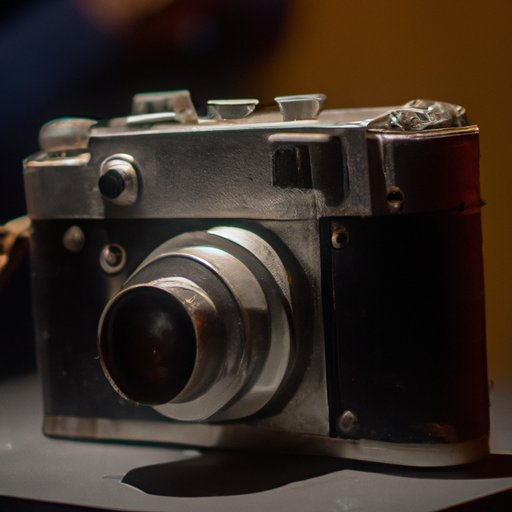Introduction
The camera has revolutionized the way we capture our lives, enabling us to document everything from special moments to everyday scenes. But when were cameras first invented? This article will explore the history of cameras and photography, from the first camera invention in the 1800s to modern-day digital photography. It will trace the origins of the camera and examine its impact on capturing life.
A History of the Camera: When Were Cameras First Invented?
The history of the camera dates back centuries. Early cameras were used as far back as the 4th century BC, when the Chinese philosopher Mo Di described a pinhole camera obscura – a box with a small hole in one side that projects an image onto the opposite wall. The camera obscura was used in Europe during the Renaissance period for drawing and painting, and it wasn’t until the 19th century that the first camera invention was made.

The Invention of the Camera: Tracing its Origins Back to the 1800s
In 1816, French inventor Joseph Niépce developed the first permanent photographic image. Niépce used a camera obscura to expose a pewter plate coated with bitumen to light. After several hours, he was able to produce a faint but permanent image. This marked the beginning of the era of modern photography.
In 1839, Louis Daguerre and William Fox Talbot developed two different processes for producing photographs. Daguerre’s process involved exposing a metal plate to light and then developing the image on the plate using mercury vapors. Talbot’s process involved using paper or cloth treated with silver chloride, which produced a negative image. These two processes sparked a new era in photography, with cameras becoming more widely available and accessible.

Exploring the Evolution of Photography: From the First Camera to Now
Since the invention of the camera in the 1800s, there have been many advancements in camera technology and photography. Today, there are many different types of cameras available, from traditional film cameras to digital cameras and even smartphones. Each type of camera has its own advantages and disadvantages, depending on what type of photography you are trying to achieve.
Digital cameras, for example, offer the advantage of being able to take multiple shots without having to reload film. They also allow you to instantly view your photos and make adjustments if needed. Smartphones are another type of camera, offering the convenience of being able to take pictures on the go. Smartphone cameras have become increasingly popular due to their portability and affordability.
A Closer Look at the Origins of Photography: When Was the Camera Invented?
The invention of the camera can be attributed to several inventors, including Joseph Niépce, Louis Daguerre, and William Fox Talbot. Niépce is credited with developing the first permanent photographic image in 1816, while Daguerre and Talbot developed their own processes for producing photographs in the 1830s and 1840s. Their inventions helped launch the era of modern photography.
Other major contributors to the development of the camera include George Eastman and Edwin Land. Eastman invented the Kodak camera in 1888, which made photography more accessible and affordable. Land, meanwhile, invented the Polaroid camera in 1948, which allowed people to take and print photographs instantly.

How Cameras Changed the Way We Capture Life: A Look at the Early Days of Photography
Before the invention of the camera, capturing images of life was a difficult and often inaccurate task. Painters and illustrators had to rely on their own artistic abilities to create images, which could be time-consuming and often not as accurate as a photograph. The invention of the camera changed all this, allowing people to easily and accurately capture images of life.
The camera has had a significant impact on the way we capture life, from the birth of a baby to a momentous event like a wedding. Cameras have enabled us to document and remember these special occasions, creating a lasting legacy that can be shared with future generations.
Examining the Impact of the Camera: A Timeline of Its Invention and Development
Since its invention in the early 1800s, the camera has undergone a number of advancements and changes. Here is a timeline of some of the key dates in the history of the camera:
- 1816 – Joseph Niépce develops the first permanent photographic image.
- 1839 – Louis Daguerre and William Fox Talbot develop their own processes for producing photographs.
- 1888 – George Eastman invents the Kodak camera.
- 1948 – Edwin Land invents the Polaroid camera.
- 1975 – Sony introduces the first consumer video camera.
- 1981 – Sony releases the first camcorder.
- 1995 – Nikon introduces the first digital single-lens reflex (DSLR) camera.
- 2007 – Apple launches the iPhone, introducing a new era of mobile photography.
These significant advancements in camera technology have made photography more accessible and user-friendly, while also paving the way for innovations such as digital photography and smartphone photography.
Conclusion
The camera has come a long way since its invention in the early 1800s. From the first permanent photographic image developed by Joseph Niépce to the introduction of the iPhone in 2007, the camera has revolutionized the way we capture life. Its invention has enabled us to document and remember special moments, creating a lasting legacy that can be shared with future generations.
The history of the camera is an ongoing story, with new advancements and innovations in camera technology constantly being made. As photography continues to evolve, the camera will remain a key tool for capturing life and preserving memories.
(Note: Is this article not meeting your expectations? Do you have knowledge or insights to share? Unlock new opportunities and expand your reach by joining our authors team. Click Registration to join us and share your expertise with our readers.)
